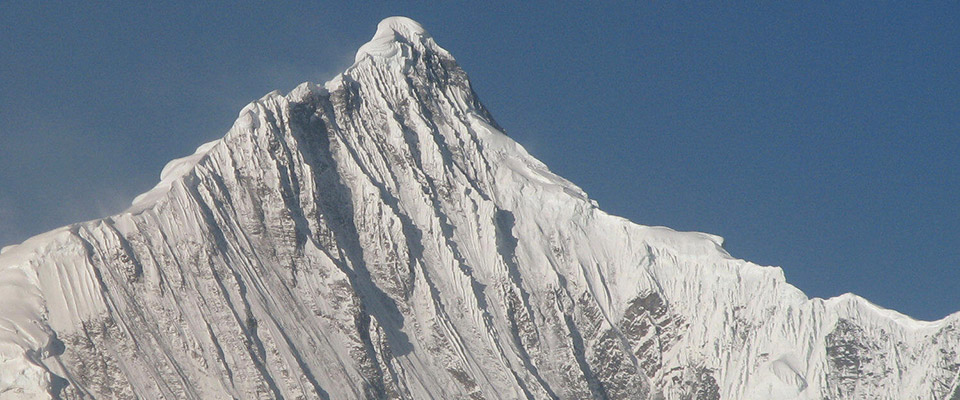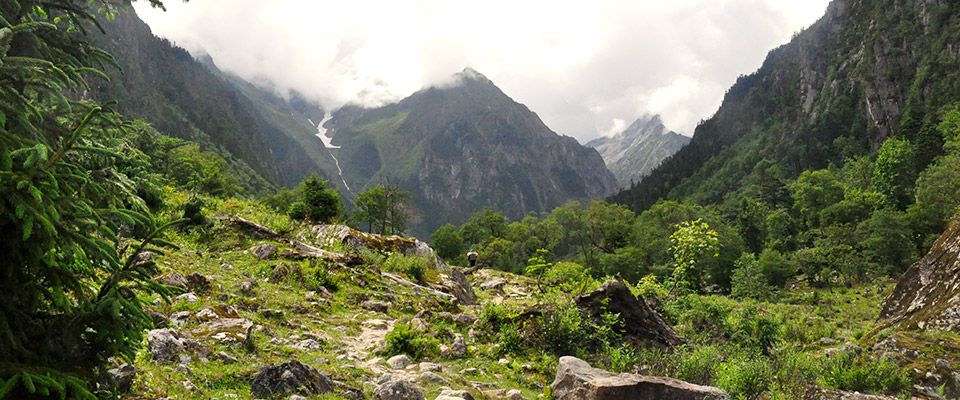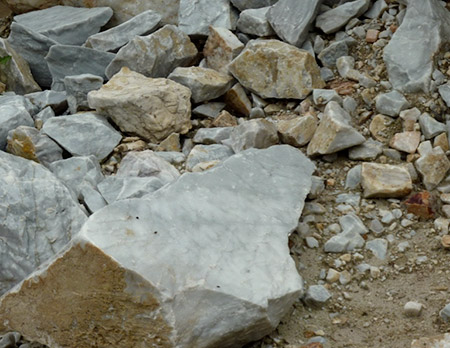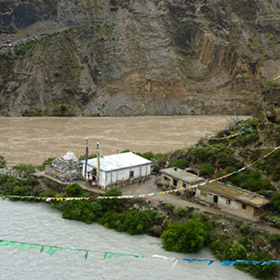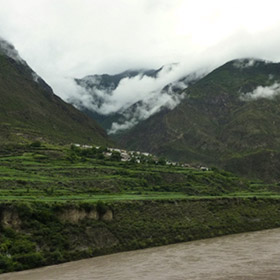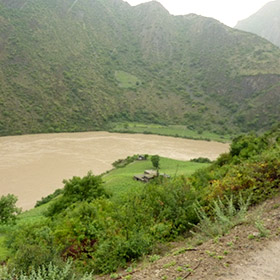Mt. Кавагебо з'яўляецца адной з самых паважаных святых гор і ўяўляе важную культуру Паўднёвага Тыбету. Кава азначае белы, а гебо азначае гару на мясцовай тыбецкай мове. У гарах Кавагебо складаны клімат, геалагічныя і экалагічныя ўмовы: ад самай нізкай даліны ракі да самай высокай вяршыні ёсць перапад вышынь 4900 метр, які стварае выразныя кліматычныя паясы: субтрапічныя гарачыя сухія даліны рэк, скроневыя горы, барэальныя горы і ледавіковыя шчыты. Тыпы расліннасці вар'іруюцца ад сухіх хмызнякоў, субтрапічныя горныя лясы, Барэальныя лясы, Альпійскія лугі да высакагорнай тундры. У той час як большая частка гары. Кавагебо, прызнаны запаведнай тэрыторыяй, заходняя частка, ахоплівае частку прэфектуры Чаю ў Тыбеце, не ўваходзіць у Нацыянальны парк з-за гарачага сухога клімату і рэдкай расліннасці.
Mt. Кавагебо першапачаткова лічыўся тыбетцамі домам Цана, магутнае бажаство. З прыходам у рэгіён будыстаў прыкладна ў 8 ст, боства ператварылася ў абаронцу будызму, і быў перайменаваны ў Кавагебо. На працягу стагоддзяў, былі пракладзены шляхі паломніцтва, якія сёння ўключаюць розныя святыя прыродныя месцы, такія як святыя вадаёмы (фантаны, азёр і вадаспадаў) і святыя скалы (камяні, скалы, пячоры). Паломніцкія шляхі злучаюць святыя месцы, якія напаўняюць увесь ландшафт сэнсам сакральнасці. Да такіх месцаў адносяцца манастыры, дзе праходзяць духоўнае ўдасканаленне выбітныя манахі.
Мясцовыя тыбецкія сяляне, якія жывуць вакол круга паломнікаў, лічаць гару сваім абаронцам, і яны выкарыстоўваюць шэраг традыцыйных метадаў кіравання прыроднымі рэсурсамі, такіх як Г-IAG, супольнасць святая гара і зона табу, дзе паляванне і лесанарыхтоўкі строга забаронены. У в Г-IAGa, збор пабочных лясных прадуктаў, можа быць дазволены абмежаваны пастух і іншыя віды дзейнасці. Г-IAG, дазваляюць рацыянальна выкарыстоўваць рэсурсы супольнасці, ахова водных рэсурсаў, і прадухіленне эрозіі горных схілаў, страты вады і глебы. Рытуалы і ахвяраванні выконваюцца мужчынскімі членамі сям'і ў рэгіёне: ранняй раніцай ст 5м, 10м, 15м і 30м месяца. Працягласць рытуалу і колькасць ахвяраванняў адрозніваюцца, пік, напрыклад, у першы дзень новага года.
Палітыкі і правы:
Mt. Кавагебо кіруецца ў рамках нацыянальнай палітыкі. Паблізу знаходзяцца спецыяльныя ахоўныя тэрыторыі, дзе кіраванне можа спрыяць экалагічнаму стану гары. кавагебо.
Традыцыйнае кіраванне ст Г-IAG з'яўляецца адной з найбольш важных рэлігійных практык для мясцовай тыбецкай супольнасці. Існуюць пагадненні паміж рознымі вёскамі і сем'ямі, каб гарантаваць аднаўленне драўніны і лекавых раслін, а таксама абмежаванае выкарыстанне неаднаўляльных рэсурсаў, такіх як горныя пароды і мінералы.
Вынікі
Праз культурныя і экалагічныя праекты КЦК, мясцовыя жыхары ўсё больш разумеюць важнасць уласнай культуры і прыроднага асяроддзя. Сярод мясцовых вяскоўцаў больш культурнага даверу, а таксама больш цэласнасці грамадства. Супрацоўніцтва з іншымі групамі і арганізацыямі паляпшаецца, і даследаванні табуяваных гор і лясоў (Г-IAG) будуе мост паміж мясцовымі ведамі і нацыянальным кіраваннем, а таксама міжнароднымі даследаваннямі.
Бачанне мясцовых тыбетцаў не з'яўляецца відавочным, але знаходзіцца ў іх духоўнай традыцыі. Mt. Кавагебо як святая гара з'яўляецца ядром вераванняў мясцовых жыхароў. Таму мэта складаецца ў тым, каб захаваць фізічнае, культурны і духоўны статус гар. Kawagebo і спыніць прамое або ўскоснае разбурэнне на горным целе і іх культуры.
Кааліцыя
Культурны клуб Kawagebo (KCC) хоча прасоўваць тыбецкую народную культуру і абараняць мясцовае экалагічнае і культурнае асяроддзе, але яны таксама спрабуюць прасоўваць традыцыйную культуру і канцэпцыю захавання прыроды сярод мясцовых тыбетцаў. KCC, Зарэгістраваны ў 1999 у Дэкіне, сталіца тыбецкай аўтаноміі Дыцын у правінцыі Юньнань, з'яўляецца некамерцыйнай арганізацыяй, заснаванай Silang, тыбецкі правадыр ліберыйца Дэкіна і мастак. Гэтая арганізацыя засяроджваецца на прасоўванні тыбецкай культуры, даючы бясплатныя курсы мовы і музычных інструментаў і паступова ўваходзіць у сферу аховы навакольнага асяроддзя.
Мясцовым вяскоўцам дапамагаюць міжнародныя арганізацыі, такія як The Nature Conservancy, Conservation International і PCD. Урад Дэцына і валанцёры з іншых месцаў таксама прапануюць значную падтрымку.
Дзеянне
З 2003, Культурны клуб Kawagebo праводзіць розныя акцыі для прыцягнення дасведчанасці аб мясцовых праблемах і іх вырашэнні. Прыклады - стымулы супраць празмернага збору ўраджаю, сумесныя даследчыя праекты, праекты па ачыстцы смецця і абароне мясцовых відаў раслін і жывёл.
Вяскоўцы арганізуюць пагадненне вакол вёсак гары. Паломніцкі круг Кавагебо, каб удакладніць сваю пазіцыю супраць майнинга ў рэгіёне. Нягледзячы на супраціў з боку бізнесу і ўрада, вяскоўцы напагатове, каб сутыкнуцца з нявызначанасцю ў будучыні адносна сваіх святых месцаў і прыродных рэсурсаў.
- Тыбецкая вёска Прыпынак здабычы на Свяшчэнная гара, Святая Зямля фільм праекта. Прагляд артыкула
- Чан, К.-ман & Чжоу, Я., 2007. Палітычныя магчымасці і рух супраць будаўніцтва плацін у Кітаі. У пп. 1-27.
- Карычневы, P., Магі, D. & Сюй, Я., 2008. Сацыяльна-эканамічная ўразлівасць развіцця гідраэнергетыкі Кітая. Эканамічны агляд Кітая, 19(4), стар.614-627. Наведайце артыкул
- Гунбу, Дорджэ, 2004. М.А. Панкультурны круг гары. Кавагебо і гістарычная даведка, Універсітэт Мінцу Кітая. Наведайце вэб-сайт
- І (Міжнародныя рэкі), 2007. Nujiang карта міжнародных рэк. Наведайце вэб-сайт
- Мой Дж., 2007, Святыя прыродныя аб'екты і захаванне біялагічнай прыроды ў рэгіёне Кавагебо, 10-я сустрэча МАБ ЮНЕСКА Сетка біясферных рэзерватаў Усходняй Азіі (ЕАБРН 10)
- TBS, Тыбецкае бюро статыстыкі, 2007. Тыбецкі статыстычны штогоднік 2007: Тыбецкае бюро статыстыкі. Пекін: Кітайская статыстычная выдавецкая кампанія, 2007.
- Часопіс вяртання, 2010, Культурны клуб Kawagebo. Наведайце вэб-сайт
- Case Study: Святых прыродных аб'ектаў Кхам, Тыбецкага аўтаномнага раёна, Кітай. Наведайце вэб-сайт

